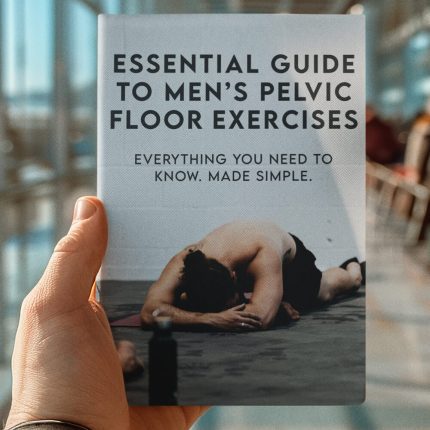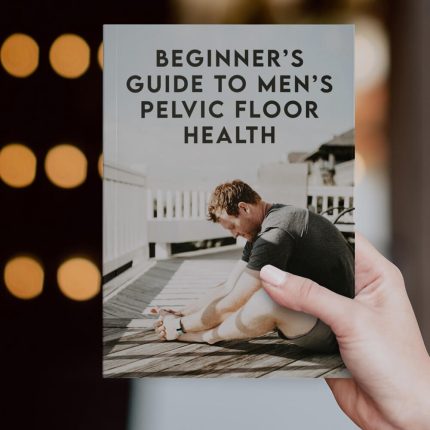Pelvic Floor Exercises for Men

Ever thought that strengthening your pelvic floor could be the secret sauce to leveling up your core, sexual health, and overall wellness? Pelvic floor exercises for men are not just another fitness fad – they’re a game-changing strategy to unlock strength from the inside out, boost your performance, and maintain a healthy, resilient body. Whether you’re a gym rat, a tech-savvy Gen Z'er, or a millennial on the go, this guide is crafted just for you. Get ready to dive in, debunk myths, and discover actionable tips that promise to transform a crucial yet underappreciated muscle group.
Quick Links to Useful Sections
- Understanding the Male Pelvic Floor
- The Benefits of Pelvic Floor Exercises for Men
- Debunking Common Myths and Misconceptions
- Myth 1: Pelvic Floor Exercises Are Only for Women
- Myth 2: They’re Not Effective Without a Gym Membership
- Myth 3: It’s Just Another Fad
- Getting Started: Easy and Effective Pelvic Floor Exercises for Men
- Kegels for Men
- Reverse Kegels
- Bridge Exercise
- Pelvic Tilts
- Squat Variations
- Integrating Pelvic Floor Fitness into Your Daily Routine
- Pair with Daily Activities
- Set Reminders on Your Devices
- Combine with Other Core Workouts
- Mindful Breathing
- Integrative Approaches to Pelvic Health for Men
- Combining Traditional Therapy with Modern Techniques
- Mind-Body Connection and Stress Management
- Integrating Nutrition into Your Wellness Plan
- Complementary Therapies: Beyond the Gym
- Resources and Community Support: Your Next Steps
- Advanced Techniques and Progressions for the Modern Man
- Integrating Resistance Training
- Dynamic Movement Routines
- High-Intensity Interval Training (HIIT) with a Core Focus
- Tracking Progress and Setting Realistic Goals
- Integrating Pelvic Floor Health into a Holistic Lifestyle
- Active Recovery and Rest
- Cross-Training and Diverse Workouts
- Holistic Health Practices
- Frequently Asked Questions About Pelvic Floor Exercises for Men
- Empowered, Active Pelvic Health for the Modern Man
Understanding the Male Pelvic Floor
The pelvic floor is a group of muscles, ligaments, and connective tissues that form a hammock-like support structure in your lower pelvis. Although often associated with women, this muscular region plays an equally crucial role in men by supporting the bladder, bowel, and sexual organs. In essence, your pelvic floor is the unsung hero of your core stability and overall health.
For men, robust pelvic floor muscles help maintain urinary and fecal continence, enhance sexual performance, and even contribute to improved athletic performance. By engaging in regular pelvic floor exercises, you not only prevent issues like incontinence and pelvic pain but also boost your stamina in everyday activities. The modern man is discovering that a strong pelvic floor is the foundation for a strong body.
Anatomical studies reveal that the male pelvic floor is deeply intertwined with your core and lower back, meaning that a well-conditioned pelvic region can improve posture and reduce the risk of injury during physical activities. With sedentary lifestyles on the rise, integrating pelvic floor exercises into your routine is a proactive step towards long-term health and performance.
The Benefits of Pelvic Floor Exercises for Men
You might be wondering, why should you pay attention to pelvic floor exercises when your typical workout routine already includes squats and deadlifts? The answer lies in specificity and targeted strength. Here’s what a solid pelvic floor routine can do for you:
Feel confident downstairs with a friendly, science based plan. No jargon. No awkward gear. Just clear steps that fit real life.
What you will learn
- How the pelvic floor works with breath and posture
- Reverse Kegels for relaxation and control
- Classic Kegels for timing and strength
- Sex stamina tools using the arousal ladder
- Bladder and bowel rituals that reduce strain
What you get
- A complete twelve week program with day by day examples
- Long step by step lessons and practice scripts
- Work and sport playbooks for busy schedules
- Printable trackers and quick cards
Perfect for
Built for men chasing stronger, longer sessions in bed, and for anyone dealing with urgent peeing, tight hips and pelvis, tricky bowel days, or healing after surgery.
Ready to start
Grab your copy and feel the difference today.
- Enhanced Core Stability: Strengthening the pelvic floor complements traditional core workouts, enhancing overall stability and reducing the risk of lower back pain.
- Improved Sexual Health: Regular pelvic floor exercises can lead to enhanced erectile function, increased stamina, and better control during intercourse.
- Urinary Control: A well-toned pelvic floor helps prevent urinary incontinence, a concern that can affect active men, particularly as they age or after prostate surgery.
- Posture and Balance: The pelvic floor is a key component of your core. Strengthening it helps improve posture, balance, and overall athletic performance.
- Enhanced Recovery: For men recovering from pelvic surgeries or injuries, targeted exercises can accelerate healing and restore function.
Beyond physical benefits, honing in on your pelvic floor cultivates a deeper awareness of your body’s inner workings, a mindfulness that translates well into other fitness pursuits and daily activities. It’s all about maintaining a holistic view of health.
Debunking Common Myths and Misconceptions
Skepticism is healthy, especially when it comes to new fitness trends. Let’s break down some of the common myths about pelvic floor exercises for men:
Myth 1: Pelvic Floor Exercises Are Only for Women
While pelvic floor exercises (often referred to as Kegels) gained popularity through women’s health campaigns, growing research and practical outcomes have shown that men benefit hugely from targeting these muscles. In fact, post-prostatectomy recovery and sexual performance are strong areas where these exercises shine.
Myth 2: They’re Not Effective Without a Gym Membership
Forget expensive memberships or specialized equipment. Pelvic floor exercises require nothing more than focus and consistency. You can perform them virtually anywhere, whether you’re chilling at home or sneaking in a workout between meetings.
Myth 3: It’s Just Another Fad
Scientific evidence supports the long-term benefits of pelvic floor training. Studies have demonstrated improvements in continence, sexual function, and general core stability, proving that this isn’t just hype but a legitimate health strategy.
Dispelling these myths is your first step towards embracing a fitness routine that’s as innovative as it is effective. With the correct approach, pelvic floor exercises can be a cornerstone of your personal wellness journey.
Getting Started: Easy and Effective Pelvic Floor Exercises for Men
Ready to activate your inner powerhouse? Whether you’re a fitness veteran or just starting your journey, these exercises are designed to strengthen your pelvic floor and integrate smoothly into your daily routine. Remember, consistency is key, so start slow and gradually build up intensity.
Kegels for Men
The traditional Kegel exercise isn’t just for women, it’s highly effective for men too. To perform a Kegel, identify the muscles you’d use to stop urine flow mid-stream. Once you’ve pinpointed these muscles, contract and hold for a count of five, then relax for an equal count. Aim for 3 sets of 10 repetitions daily.
Beginners should ensure they are not tightening their abdominal, thigh, or glute muscles. Focus solely on the pelvic floor region to maximize benefits. Gradually increase the hold time as your strength improves.
Reverse Kegels
While Kegels focus on tightening, reverse Kegels emphasize relaxing and lengthening the pelvic floor muscles. This exercise helps balance tension and can be particularly useful for managing pelvic pain. Practice by taking a deep breath, allowing your pelvic muscles to gently push downward, then exhale and return to a neutral position.
Feel confident downstairs with a friendly, science based plan. No jargon. No awkward gear. Just clear steps that fit real life.
What you will learn
- How the pelvic floor works with breath and posture
- Reverse Kegels for relaxation and control
- Classic Kegels for timing and strength
- Sex stamina tools using the arousal ladder
- Bladder and bowel rituals that reduce strain
What you get
- A complete twelve week program with day by day examples
- Long step by step lessons and practice scripts
- Work and sport playbooks for busy schedules
- Printable trackers and quick cards
Perfect for
Built for men chasing stronger, longer sessions in bed, and for anyone dealing with urgent peeing, tight hips and pelvis, tricky bowel days, or healing after surgery.
Ready to start
Grab your copy and feel the difference today.
Bridge Exercise
The bridge isn’t just a glute workout, it also activates the pelvic floor. Lie on your back with your knees bent and feet firmly planted on the floor. Slowly lift your hips until your body forms a straight line from your shoulders to your knees. As you lift, engage your pelvic floor muscles and hold the position for a few seconds before lowering back down.
Pelvic Tilts
Pelvic tilts are excellent for improving flexibility and reducing lower back tension while engaging the pelvic floor. Stand with your back against a wall or lie on your back with knees bent. Gently tilt your pelvis upward, flattening your lower back against the floor or wall. Hold for a few seconds, then release. This exercise not only tones your pelvic area but also contributes to better posture.
Squat Variations
Incorporating squats into your routine provides compound benefits, targeting the lower body while also engaging the pelvic muscles. Focus on maintaining proper form: keep your feet shoulder-width apart, back straight, and ensure your knees do not extend past your toes. As you rise back up, consciously contract your pelvic floor muscles.
These foundational exercises create a strong base for a resilient pelvic floor. Whether you’re dealing with incontinence, post-surgical recovery, or just aiming to optimize your core, incorporating these moves into your regular workout routine is a winning strategy.
EXPLORE OUR EXPERT MEN'S PELVIC FLOOR GUIDES WITH HIDDEN TIPS AND TRICKS
👨💻 Men's Pelvic Floor Book Store (Instant Download) 👨💻
Integrating Pelvic Floor Fitness into Your Daily Routine
Even the busiest of modern men can benefit from pelvic floor exercises by integrating them into everyday life. Here are some tips to make pelvic floor training a seamless part of your day:
Pair with Daily Activities
Practice your Kegels while commuting, during meetings, or even when you’re waiting in line for coffee. The simplicity and discreteness of these exercises allow you to integrate them effortlessly into your routine.
Set Reminders on Your Devices
Leverage technology to your advantage. Use smartphone apps or simple calendar reminders to prompt you to perform pelvic floor exercises throughout the day. With a few taps, you can ensure you’re consistently working on your pelvic strength.
Combine with Other Core Workouts
Enhance the benefits by pairing pelvic floor exercises with your regular core or strength training routines. This synergy can lead to better posture, increased stability, and an overall stronger midsection.
Mindful Breathing
Incorporate deep breathing techniques during your exercises. The coordination of breath with muscle engagement not only improves the quality of your contractions but also deepens your mind-body connection.
By making pelvic floor exercises a habitual element of your lifestyle, you ensure that these crucial muscles receive the attention they deserve. It’s about creating a balanced, robust fitness regime that supports every part of your body.
Feel confident downstairs with a friendly, science based plan. No jargon. No awkward gear. Just clear steps that fit real life.
What you will learn
- How the pelvic floor works with breath and posture
- Reverse Kegels for relaxation and control
- Classic Kegels for timing and strength
- Sex stamina tools using the arousal ladder
- Bladder and bowel rituals that reduce strain
What you get
- A complete twelve week program with day by day examples
- Long step by step lessons and practice scripts
- Work and sport playbooks for busy schedules
- Printable trackers and quick cards
Perfect for
Built for men chasing stronger, longer sessions in bed, and for anyone dealing with urgent peeing, tight hips and pelvis, tricky bowel days, or healing after surgery.
Ready to start
Grab your copy and feel the difference today.
Integrative Approaches to Pelvic Health for Men
Pelvic floor exercises are most effective when combined with complementary health practices. In today’s holistic health environment, men are embracing a multi-faceted approach that blends conventional workouts with mindful practices and lifestyle adjustments.
Combining Traditional Therapy with Modern Techniques
Think of your pelvic floor as a component of your overall core. Integrative approaches may involve physical therapy sessions that include biofeedback training, manual techniques, and targeted exercises to enhance muscle coordination and strength. Biofeedback devices offer real-time insights so that you can ensure optimal engagement of your pelvic muscles.
Mind-Body Connection and Stress Management
Stress can be a major culprit behind muscle tension and pelvic pain. Incorporating mindfulness practices such as meditation, deep breathing, or even yoga can help relax not only your mind but also your pelvic floor. This relaxation is critical, as it allows for better muscle recovery and reduced tension.
Integrating Nutrition into Your Wellness Plan
Your diet plays a key role in the health of your muscles, including the pelvic floor. An anti-inflammatory, nutrient-dense diet rich in lean proteins, whole grains, fruits, and vegetables supports tissue repair and reduces chronic inflammation. Proper hydration is equally important, water makes the connective tissues more flexible and improves overall function.
Complementary Therapies: Beyond the Gym
Many men find that complementary therapies such as massage, chiropractic care, and even acupuncture can provide added benefits for pelvic floor health. Massage techniques, for instance, can help relieve muscle tightness and improve blood flow, contributing to faster recovery and enhanced performance.
These integrative strategies are not about replacing your regular exercise routine but rather augmenting it with a holistic view of health. By aligning your physical workouts with diet, mental health, and complementary therapies, you create a balanced approach that supports longevity and vitality.
EXPLORE OUR EXPERT MEN'S PELVIC FLOOR GUIDES WITH HIDDEN TIPS AND TRICKS
👨💻 Men's Pelvic Floor Book Store (Instant Download) 👨💻
Resources and Community Support: Your Next Steps
Embarking on a journey to improve your pelvic floor health doesn’t have to be a solo mission. There are growing communities, expert resources, and professional networks devoted to men’s pelvic health. Whether it’s online forums, social media groups, or local wellness centers, you have access to advice, shared experiences, and professional support.
Do not hesitate to reach out to pelvic health specialists who can conduct customized assessments and guide you towards a personalized exercise regimen. Many clinics now offer virtual consultations, making it easier than ever to get professional advice without stepping out of your door.
Additionally, numerous apps and wearable devices are designed to track your progress, offer guided workouts, and even remind you to perform your exercises throughout the day. This tech integration helps you stay committed and accountable, transforming your pelvic floor workouts from a chore into a modern, engaging ritual.
Remember, the journey to improved pelvic floor health is a marathon, not a sprint. Celebrate every improvement, no matter how small, and join communities that celebrate holistic wellness. Your journey toward a stronger, healthier pelvic floor is also a journey toward a more vibrant and confident you.
Advanced Techniques and Progressions for the Modern Man
Once you’ve mastered the basics of pelvic floor exercises, it’s time to explore advanced techniques that can further challenge and refine your core stability. These progressions are perfect for the modern man who’s looking to take his pelvic health to the next level.
Integrating Resistance Training
Adding external resistance, whether through weighted exercises or resistance bands, can amplify the benefits of your pelvic floor training. Exercises like weighted squats, lunges, and even deadlifts, when performed with mindfulness toward your pelvic muscles, enhance both strength and endurance.
Dynamic Movement Routines
Incorporate movements that simulate real-life activities to boost functional strength. Consider exercises that involve dynamic shifting of positions, such as transitioning from a plank to a bridge, or combining pelvic tilts with stability ball workouts. These pushes help condition your body for everyday challenges while keeping your workout engaging and unexpected.
High-Intensity Interval Training (HIIT) with a Core Focus
HIIT routines that emphasize core stability introduce an element of cardiovascular fitness alongside pelvic floor engagement. Short bursts of intense exercise followed by recovery periods can boost your metabolic rate while reinforcing muscle memory in your pelvic region.
As you experiment with these advanced techniques, always listen to your body. Overexertion can lead to muscle fatigue or strain, so balancing intensity with ample recovery is essential to ensuring long-term benefits and avoiding injury.
Tracking Progress and Setting Realistic Goals
The key to success in any fitness regimen is to set clear, measurable goals and then track your progress. When it comes to pelvic floor exercises, even subtle improvements can lead to significant changes in overall health and quality of life.
Use journaling or digital tracking apps to log your exercise sessions, note any reductions in symptoms like urinary leakage or discomfort, and record improvements in sexual function. Over time, you’ll be able to see a clear trajectory of improvement that motivates you to push further.
Remember that progress isn’t always linear, some days may feel tougher than others, but consistency is what ultimately makes the difference. Celebrate every milestone, whether it's being able to hold a contraction longer or noticing improved posture throughout the day.
Integrating Pelvic Floor Health into a Holistic Lifestyle
Embracing pelvic floor exercises for men is just one facet of a broader lifestyle approach that prioritizes overall well-being. To truly harness the benefits, integrate these exercises with other healthy habits.
Active Recovery and Rest
A balanced lifestyle includes not just exercise, but rest and recovery as well. Allow time for muscle repair by prioritizing quality sleep and incorporating active recovery days with light stretching, yoga, or meditation.
Cross-Training and Diverse Workouts
Keep your routine exciting by incorporating a variety of workouts, whether it’s strength training, cardio, flexibility exercises, or mobility drills. Each form of exercise contributes uniquely to building a stable and robust core.
Holistic Health Practices
Explore mindfulness practices that enhance the mind-body connection. Meditation, guided breathing exercises, and even journaling can help reduce stress and improve the overall effectiveness of your workout regimen.
By viewing your pelvic floor health as a cornerstone of your broader wellness journey, you empower yourself to make comprehensive lifestyle changes. The effects extend far beyond physical fitness, uplifting your mental clarity, resilience, and overall quality of life.
EXPLORE OUR EXPERT MEN'S PELVIC FLOOR GUIDES WITH HIDDEN TIPS AND TRICKS
👨💻 Men's Pelvic Floor Book Store (Instant Download) 👨💻
Frequently Asked Questions About Pelvic Floor Exercises for Men
To wrap things up, here are some of the most frequently asked questions that many men have about pelvic floor exercises. We’ve integrated a FAQ schema to ensure you can readily access expert insights.
1. What exactly are pelvic floor exercises for men?
Pelvic floor exercises are targeted routines designed to strengthen the muscles that support the bladder, bowel, and sexual organs. For men, these exercises improve core stability, enhance sexual performance, and help prevent urinary incontinence.
2. Can pelvic floor exercises help with post-prostatectomy recovery?
Yes, many men undergoing prostate surgery incorporate pelvic floor exercises to speed up recovery, regain continence, and improve overall pelvic strength. Always consult your healthcare provider for personalized guidance.
3. How often should I perform these exercises?
Consistency is key. Aim to do sets of Kegels and complementary exercises daily, starting with 10 repetitions per set and increasing as your strength improves.
4. Will I see improvements in my sexual health?
Absolutely. Strengthening the pelvic floor not only improves physical function but can also enhance erectile function, increase stamina, and boost overall sexual satisfaction.
5. Do I need any special equipment?
No special equipment is required to start pelvic floor exercises. However, some men find that using biofeedback devices or smartphone apps can assist with proper technique and tracking progress.
6. Can these exercises help with lower back pain?
Yes, because the pelvic floor is part of your core, strengthening it can improve posture and reduce strain on your lower back.
7. How soon can I expect results?
Results vary by individual, but with consistency, many men report improvements in strength, continence, and sexual health within a few months.
8. Are there any risks involved?
When performed correctly, pelvic floor exercises are safe. Be sure to learn the proper technique to avoid over-tightening or straining other muscles. A consultation with a pelvic health specialist can help tailor the program to your needs.
Empowered, Active Pelvic Health for the Modern Man
Your journey to a robust pelvic floor is a journey to a stronger, healthier you. By incorporating these exercises into your daily routine, you’re investing in your future, one that’s defined by enhanced core strength, improved sexual health, and greater overall wellness. Think of each contraction, each mindful breath, as a declaration of empowerment, a commitment to your long-term vitality.
Whether you’re recovering from surgery, managing stress-related pelvic discomfort, or simply seeking to optimize your fitness, pelvic floor exercises for men offer benefits that extend far beyond the gym. They bolster your resilience, fuel your confidence, and pave the way for a balanced lifestyle where body and mind operate in perfect harmony.
Embrace the journey with curiosity and consistency, celebrating every milestone along the way. As modern men, it’s time we recognize that strength isn’t just about biceps and abs, it’s about nurturing every part of our body. Step into this transformative practice and let your pelvic health be the catalyst for overall wellness.
From integrating daily exercises to exploring advanced training methods, the power to revolutionize your health lies within. So start today, commit to consistency, and watch as each small effort contributes to monumental gains. Your pelvic floor is calling, answer with strength, humor, and resilience.
Feel confident downstairs with a friendly, science based plan. No jargon. No awkward gear. Just clear steps that fit real life.
What you will learn
- How the pelvic floor works with breath and posture
- Reverse Kegels for relaxation and control
- Classic Kegels for timing and strength
- Sex stamina tools using the arousal ladder
- Bladder and bowel rituals that reduce strain
What you get
- A complete twelve week program with day by day examples
- Long step by step lessons and practice scripts
- Work and sport playbooks for busy schedules
- Printable trackers and quick cards
Perfect for
Built for men chasing stronger, longer sessions in bed, and for anyone dealing with urgent peeing, tight hips and pelvis, tricky bowel days, or healing after surgery.
Ready to start
Grab your copy and feel the difference today.
Curious About Your Pelvic Floor? Explore our curated collection of insightful articles to learn more and take charge of your health.
- Pelvic Floor Basics
- Pelvic Floor Exercises & Workouts
- Pelvic Floor Kegel Exercises: Techniques & Benefits
- Advanced Pelvic Floor Workouts
- Pre/Post-Natal Pelvic Floor Routines
- Pelvic Floor Exercises for Men
- Pelvic Floor Therapy Techniques
- At-home vs Professional Pelvic Floor Therapy Options
- Diet & Lifestyle for a Healthy Pelvic Floor
- Pelvic Floor Health & Wellness
- Specialized Pelvic Floor Conditions & Treatments
Now back to the main article!
















